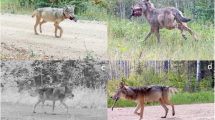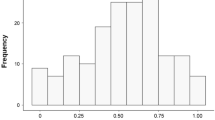Summary
Females of the desert grassland scorpion Paruroctonus utahensis were maintained in field enclosures and fed differing amounts of food. The number of young scorpions per female varied from 0 to 32. The mean weight of second-instar young varied significantly among broods. The number of young, the size of the young, and total brood weight were not related to adult female size. There were no significant relationships between any of the brood characteristics and the amount of food eaten by the mother during the 11 month gestation. This suggests that foraging success is not an important proximate factor influencing fecundity in Paruroctonus utahensis.
Similar content being viewed by others
References
Bellows TS Jr (1982) Analytical models for laboratory populations of Callosobruchus chinensis and Callosobruchus maculatus (Coleoptera Bruchidae). J Anim Ecol 51:263–288
Boddington MJ, Mettrick DF (1977) A laboratory study of the population dynamics and productivity of Dugesia polychroa (Turbellaria Tricladida). Ecology 58:109–118
Bradley RA (1982) Digestion time and reemergence in the desert grassland scorpion Paruroctonus utahensis (Williams) (Scorpionida, Vaejovidae). Oecologia (Berlin) 55:316–318
Bradley RA (1983) Activity and population dynamics of the desert grassland scorpion (Paruroctonus utahensis): does adaptation imply optimization? PhD Dissertation Univ New Mexico, p 282
Chua TH, Chandrapal R (1978) The influence of restricted food supplies on the development of larvae and on the fecundity of Palembus dermestoides (Tenebrionidae). Malays J Stored Prod Res 14:81–86
Cohen D (1966) Optimizing reproduction in a randomly varying environment. J Theoret Biol 12:119–129
Collins NC (1980) Developmental responses to food limitation as indicators of environmental conditions for Ephydra cinerea Diptera. Ecology 61:650–661
Cornelius M, Barlow CA (1980) Effect of aphid consumption by larvae on development and reproductive efficiency of a flower fly Syrphus corollae Diptera Syrphidae. Can Entomol 112:989–992
Daborn GR, Hayward JA, Quinney TE (1978) Studies on Daphnia pulex in sewage oxidation ponds. Can J Zool 56:1392–1401
Eisenberg RM, Hurd LE, Bartley JA (1981) Ecological consequences of food limitation for adult mantids Tenodera ardifolia sinensis. Am Midl Nat 106:209–218
Francke OF (1976) Observations on the life history of Uroctonus mordax Thorell (Scorpionida, Vaejovidae). Bull Br Arachnol Soc 3:254–260
Francke OF (1979) Observations on the reproductive biology and life history of Megacormus gertschi Diaz (Scorpiones: Chactidae; Megacorminae). J Arachnol 7:223–230
Francke OF (1982) Birth behavior and life history of Diplocentrus spitzeri Stahnke (Scorpiones: Diplocentridae). Southwestern Nat 25:517–523
Harris RP (1977) Some aspects of the biology of the harpacticoid copepod Scottolana canadensis maintained in laboratory culture. Chesapeake Sci 18:245–252
Hines AH (1982) Allometric constraints and variables of reproductive effort in brachyuran crabs. Mar Biol 69:309–320
Horton CC, Wise DH (1983) The experimental analysis of competition between two syntopic species of orb-web spiders (Araneae: Araneidae). Ecology 64:929–944
Kautsky N (1982) Quantitative studies on gonad cycle, fecundity, reproductive output, and recruitment in a Baltic Mytilus edulis population. Mar Biol 68:143–160
Koop K, Field JG (1980) The influence of food availability on population dynamics of a supralittoral isopod Ligia dilatata. J Exp Mar Biol Ecol 48:61–72
Lampert W (1978) A field study of the dependence of the fecundity of Daphnia sp. on food concentration. Oecologia (Berlin) 36:363–370
Lucas JS (1980) Spider crabs of the family Hymenosomatidae crustacea Brachyura with particular reference to Australia species systematics and biology. Rec Aust Mus 33:148–247
McAlister WH (1960) Early growth rates in offspring from two broods of Vejovis spinigerus Wood. Texas J Sci 4:158–162
Millot J, Vachon M (1949) Ordre des scorpions. In: P. Grasse (ed) Traite de zoologie: anatomie, systematique, biologie, v. VI. Masson, Paris, pp 386–436
Polis GA (1981) The evolution and dynamics of intraspecific predation. Ann Rev Ecol Syst 12:225–251
Polis GA, Farley RD (1979) Characteristics and environmental determinants of natality, growth and maturity in a natural population of the desert scorpion, Paruroctonus mesaensis (Scorpionida: Vaejovidae). J Zool Lond 187:517–542
Rao CN, Ponnuchamy R, Shakuntala K, Reddy SR (1981) Fecundity and energetics of embryonic metabolism of Caridina weberi Decapoda Atyidae. Int J Invert Reprod 3:75–86
Riechert SE, Cady AB (1983) Patterns of resource use and tests for competitive release in a spider community. Ecology 64:899–913
Robertson AI, Mann KH (1982) Population dynamics and life history adaptations of Littorina neglecta in an eelgrass meadow Zostera marina in Nova Scotia Canada. J Exp Mar Biol Ecol 63:151–172
Schaefer M (1978) Some experiments on the regulation of population density in the spider Floronia bucculenta (Araneida: Linyphiidae). Symp Zool Soc Lond 42:203–210
Schiemer F (1982) Food dependence and energetics of free living nematodes Z. Life history parameters of Caenorhabditis briggsae (Nematoda) at different levels of food supply. Oecologia (Berlin) 54:122–128
Schiemer F, Duncan A, Klekowski RZ (1980) A bioenergetic study of a benthic nematode Plectus palustris throughout its life cycle 2. Growth fecundity and energy budgets at different densities of bacterial food and general ecological considerations. Oecologia (Berlin) 44:205–212
Slansky F Jr (1980) Effect of food limitation on food consumption and reproductive allocation by adult milkweed bugs, Oncopeltus fasciatus. J Insect Physiol 26:79–84
Tarwid M (1976) Validity of egg cocoons of the spider Tetragnatha montana under various ecological conditions. Bull Acad Pol Sci Ser Sci Biol 24:593–596
Tashiro JS (1982) Grazing in Bithynia tentaculata age specific bioenergetic patterns in reproductive partitioning of ingested carbon and nitrogen. Am Midl Nat 107:133–150
Todd CD (1979) Reproductive energetics of 2 species of dorid nudibranchs with plantotrophic and lecithotrophic larval stages. Mar Biol 53:57–68
Wise DH (1975) Food limitation in the spider Linyphia marginata: experimental field studies. Ecology 56:637–646
Wise DH (1979) Effects of an experimental increase in prey abundance upon the reproductive rates of two orb-weaving spider species (Araneae: Araneidae). Oecologia (Berlin) 41:289–300
Wise DH (1983) Competitive mechanisms in a food-limited species: relative importance of interference and exploitative interactions among labyrinth spiders (Araneae: Araneidae). Oecologia (Berlin) 58:1–9
Woodward IO, White RWG (1981) Effects of temperature and food on the fecundity and egg development rates of Boeckella symmetrica (Copepoda Calanoida). Aust J Mar Freshwater Res 32:997–1002
Author information
Authors and Affiliations
Rights and permissions
About this article
Cite this article
Bradley, R.A. The influence of the quantity of food on fecundity in the desert grassland scorpion (Paruroctonus utahensis) (Scorpionida, Vaejovidae): An experimental test. Oecologia 62, 53–56 (1984). https://doi.org/10.1007/BF00377372
Received:
Issue Date:
DOI: https://doi.org/10.1007/BF00377372




